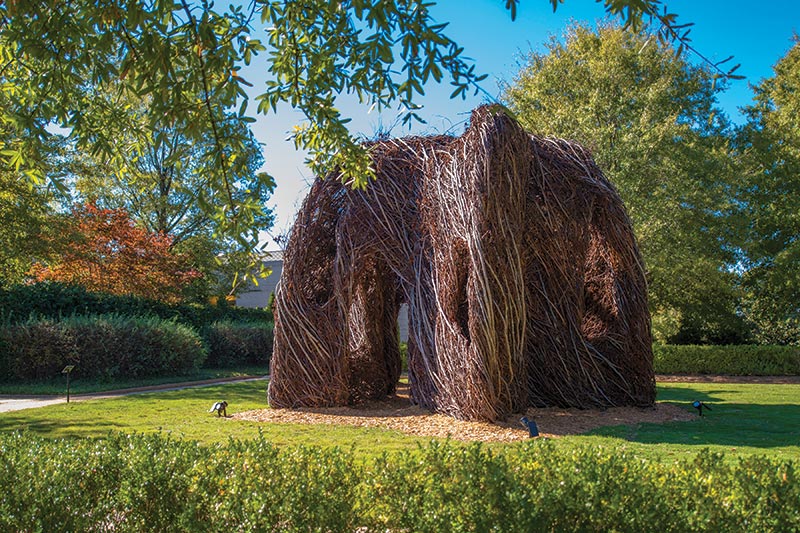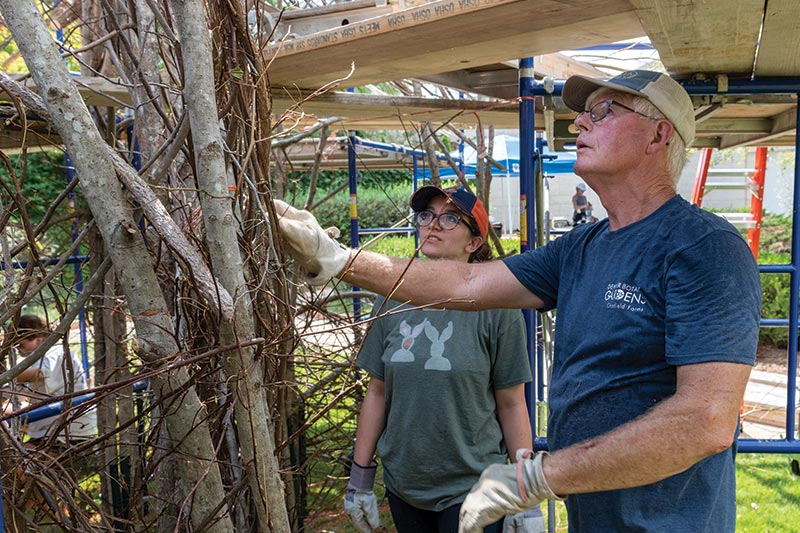Sculpting a Vision Into Reality
Article body
It took hundreds of volunteers, thousands of labor hours in the blazing summer sun and a veritable forest of Alabama sweetgum, but Patrick Dougherty’s latest “stickwork” installation now stands in all its captivating, whimsical beauty at the Jule Collins Smith Museum of Fine Art at Auburn University.
This past September, Dougherty, the acclaimed environmental sculptor who served as guest juror for the museum’s biennial 2019–20 “Out of the Box: An Outdoor Juried Sculpture Exhibition,” rolled up his sleeves and set to work constructing one of his signature tree sapling sculptural works on the museum’s north lawn.
Dougherty sculpts on a gargantuan scale, with some of his spiraling, cottage-sized structures reaching more than 25 feet in height. His project for the museum, “Down Where Paradise Lays,” resembles a multi-roomed hobbit home, its construction demanding vast bundles of locally sourced Alabama sweetgum trees and a dedicated interdepartmental volunteer effort to complete the sculpture on time.
“Given the scale and content of Patrick’s work, we recognized the opportunity for a rare collaboration among campus departments, such as forestry, architecture and building science,” said Jessica Hughes, curatorial assistant and co-coordinator of the “Out of the Box” exhibition. “Forestry students, in particular, harvested much of the native sweetgum saplings used to construct the large-scale structures, and architecture and building science students participated in the sapling preparation and construction phase of the project.”
The Department of Art and Art History also assisted in the process, with drawing and sculpture classes aiding in construction and students taking the opportunity for hands-on learning—sketching from life and developing wood-weaving techniques.
“In total, we had nearly 200 volunteers across departments,” Hughes said. “We wanted to offer those varied individuals the opportunity to not only work with a world-renowned artist but facilitate the expansion and development of professional practices across disciplines, all while collaborating on the creation of a one-of-a-kind work of art that delights and engages museum visitors.”
Over the course of three decades, Dougherty has crafted more than 300 giant-sized tree sculptures in public spaces throughout the world. He is the recipient of numerous awards and the subject of profiles in major media outlets, including The New York Times and CBS Sunday Morning.
“It has been an honor for the museum to host an artist like Patrick Dougherty,” said museum director and chief curator Cindi Malinick. “His awe-inspiring sweetgum creation beautifully reflects the intersection of art with Auburn University's land-grant legacy.”
Dougherty’s installation, made entirely of biodegradable environmental materials, will remain on exhibit at the museum at least through Oct. 4, 2020, and then for as long as it remains structurally viable.
Auburn University is a nationally ranked land grant institution recognized for its commitment to world-class scholarship, interdisciplinary research with an elite, top-tier Carnegie R1 classification and an undergraduate education experience second to none. Auburn is home to more than 30,000 students, and its faculty and research partners collaborate to develop and deliver meaningful scholarship, science and technology-based advancements that meet pressing regional, national and global needs. Auburn's commitment to active student engagement, professional success and public/private partnership drives a growing reputation for outreach and extension that delivers broad economic, health and societal impact. Auburn's mission to educate, discover and collaborate drives its expanding impact on the world.



